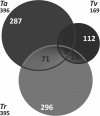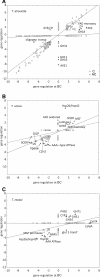Comparative transcriptomics reveals different strategies of Trichoderma mycoparasitism
- PMID: 23432824
- PMCID: PMC3599271
- DOI: 10.1186/1471-2164-14-121
Comparative transcriptomics reveals different strategies of Trichoderma mycoparasitism
Abstract
Background: Trichoderma is a genus of mycotrophic filamentous fungi (teleomorph Hypocrea) which possess a bright variety of biotrophic and saprotrophic lifestyles. The ability to parasitize and/or kill other fungi (mycoparasitism) is used in plant protection against soil-borne fungal diseases (biological control, or biocontrol). To investigate mechanisms of mycoparasitism, we compared the transcriptional responses of cosmopolitan opportunistic species and powerful biocontrol agents Trichoderma atroviride and T. virens with tropical ecologically restricted species T. reesei during confrontations with a plant pathogenic fungus Rhizoctonia solani.
Results: The three Trichoderma spp. exhibited a strikingly different transcriptomic response already before physical contact with alien hyphae. T. atroviride expressed an array of genes involved in production of secondary metabolites, GH16 ß-glucanases, various proteases and small secreted cysteine rich proteins. T. virens, on the other hand, expressed mainly the genes for biosynthesis of gliotoxin, respective precursors and also glutathione, which is necessary for gliotoxin biosynthesis. In contrast, T. reesei increased the expression of genes encoding cellulases and hemicellulases, and of the genes involved in solute transport. The majority of differentially regulated genes were orthologues present in all three species or both in T. atroviride and T. virens, indicating that the regulation of expression of these genes is different in the three Trichoderma spp. The genes expressed in all three fungi exhibited a nonrandom genomic distribution, indicating a possibility for their regulation via chromatin modification.
Conclusion: This genome-wide expression study demonstrates that the initial Trichoderma mycotrophy has differentiated into several alternative ecological strategies ranging from parasitism to predation and saprotrophy. It provides first insights into the mechanisms of interactions between Trichoderma and other fungi that may be exploited for further development of biofungicides.
Figures






Similar articles
-
Identification of effector-like proteins in Trichoderma spp. and role of a hydrophobin in the plant-fungus interaction and mycoparasitism.BMC Genet. 2017 Feb 15;18(1):16. doi: 10.1186/s12863-017-0481-y. BMC Genet. 2017. PMID: 28201981 Free PMC article.
-
Transcriptomic response of the mycoparasitic fungus Trichoderma atroviride to the presence of a fungal prey.BMC Genomics. 2009 Nov 30;10:567. doi: 10.1186/1471-2164-10-567. BMC Genomics. 2009. PMID: 19948043 Free PMC article.
-
TBRG-1 a Ras-like protein in Trichoderma virens involved in conidiation, development, secondary metabolism, mycoparasitism, and biocontrol unveils a new family of Ras-GTPases.Fungal Genet Biol. 2020 Mar;136:103292. doi: 10.1016/j.fgb.2019.103292. Epub 2019 Nov 12. Fungal Genet Biol. 2020. PMID: 31730908
-
Trichoderma: the genomics of opportunistic success.Nat Rev Microbiol. 2011 Sep 16;9(10):749-59. doi: 10.1038/nrmicro2637. Nat Rev Microbiol. 2011. PMID: 21921934 Review.
-
Novel traits of Trichoderma predicted through the analysis of its secretome.FEMS Microbiol Lett. 2012 Dec;337(1):1-9. doi: 10.1111/j.1574-6968.2012.02665.x. Epub 2012 Sep 18. FEMS Microbiol Lett. 2012. PMID: 22924408 Free PMC article. Review.
Cited by
-
Endophytic Fungi as Potential Biocontrol Agents against Rhizoctonia solani J.G. Kühn, the Causal Agent of Rice Sheath Blight Disease.Biology (Basel). 2022 Aug 29;11(9):1282. doi: 10.3390/biology11091282. Biology (Basel). 2022. PMID: 36138761 Free PMC article.
-
Expression of Saccharomyces cerevisiae RER2 Gene Encoding Cis-Prenyltransferase in Trichoderma atroviride Increases the Activity of Secretory Hydrolases and Enhances Antimicrobial Features.J Fungi (Basel). 2022 Dec 26;9(1):38. doi: 10.3390/jof9010038. J Fungi (Basel). 2022. PMID: 36675859 Free PMC article.
-
The importance of chorismate mutase in the biocontrol potential of Trichoderma parareesei.Front Microbiol. 2015 Oct 27;6:1181. doi: 10.3389/fmicb.2015.01181. eCollection 2015. Front Microbiol. 2015. PMID: 26579090 Free PMC article.
-
Containment of Fusarium culmorum and Its Mycotoxins in Various Biological Systems by Antagonistic Trichoderma and Clonostachys Strains.J Fungi (Basel). 2023 Feb 22;9(3):289. doi: 10.3390/jof9030289. J Fungi (Basel). 2023. PMID: 36983457 Free PMC article.
-
Effect of Oligosaccharide Degree of Polymerization on the Induction of Xylan-Degrading Enzymes by Fusarium oxysporum f. sp. Lycopersici.Molecules. 2020 Dec 11;25(24):5849. doi: 10.3390/molecules25245849. Molecules. 2020. PMID: 33322262 Free PMC article.
References
-
- Benítez T, Rincón AM, Limón MC, Codón AC. Biocontrol mechanisms of Trichoderma strains. Int Microbiol. 2004;7:249–260. - PubMed
-
- Kubicek CP, Herrera-Estrella A, Seidl-Seiboth V, Martinez DA, Druzhinina IS, Thon M, Zeilinger S, Casas-Flores S, Horwitz BA, Mukherjee PK, Mukherjee M, Kredics L, Alcaraz LD, Aerts A, Antal Z, Atanasova L, Cervantes-Badillo MG, Challacombe J, Chertkov O, McCluskey K, Coulpier F, Deshpande N, von Döhren H, Ebbole DJ, Esquivel-Naranjo EU, Fekete E, Flipphi M, Glaser F, Gómez-Rodríguez EY, Gruber S. Comparative genome sequence analysis underscores mycoparasitism as the ancestral life style of Trichoderma. Genome Biol. 2011;12(4):R40. doi: 10.1186/gb-2011-12-4-r40. - DOI - PMC - PubMed
Publication types
MeSH terms
LinkOut - more resources
Full Text Sources
Other Literature Sources
Molecular Biology Databases
Miscellaneous

